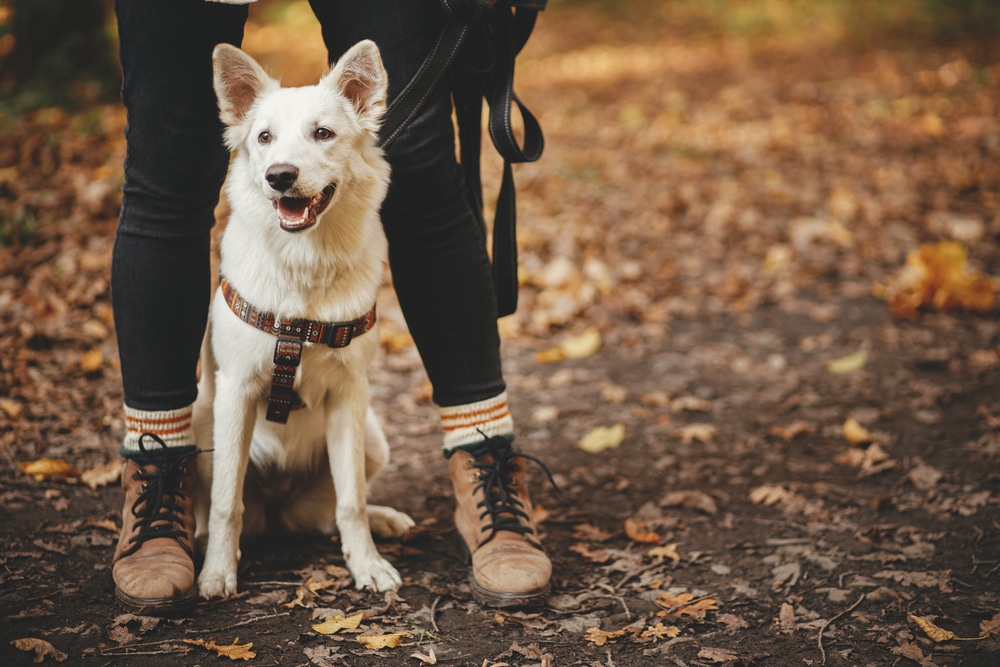Hiking with dogs is a fun activity. However, there are certain measures that should be taken before going out for a hike with your dog. We’re going to tell you what those measures are. In other words, this is how to go hiking with your dog.
Hiking with your dog requires a lot of pre-planning that includes selecting a place to hike and a trail that allows hiking with dogs. Always keep the dog on a leash and on the trail. Keep fresh water, disposal bags, and a pet first aid kit with you too, along with some spare food for your dog. Remember to check your dog for ticks when finished and, if needed, schedule an appointment with your veterinarian if you notice anything unusual post-hike. You can also schedule one prior to making sure your dog is fit for exercise and being outdoors.
Table of Contents
- Hiking: An Adventurous Activity With Benefits For Both You And Your Dog
- Selecting A Place For A Hike With Your Dog
- Preparations Before Going Out For A Hike
- A General Health Checkup Of Your Dog
- Flea And Tick Prevention Measures
- What Should You Have In A Pet Hiking Kit?
- Why Should You Always Keep A Dog On Leash While Hiking?
- Rules Of Hiking With A Dog
- Training A Dog For A Hike
- A Post-Hike Health Checkup And Grooming
- Conclusion: How To Go Hiking With A Dog?
Hiking: An Adventurous Activity With Benefits For Both You And Your Dog
Hiking is a healthy exercise and can benefit you and your dog in terms of physical health, keeping you fit, and bringing you closer to nature. Dogs are active beings and get bored with staying home all day. So, a hike can provide something fun for you and your dog to do. Moreover, a hike alongside your companion strengthens the human-dog bond, and the shared memories and experiences establish a lasting relationship.
Selecting A Place For A Hike With Your Dog
The first and foremost step in planning a hike is to select an appropriate place, a trail that allows hiking alongside a dog. The place should be easily accessible and have safe terrain with minimal risk of wild animals. Get any prior permissions in case you aren’t sure whether the authorities allow dogs there or not.
Preparations Before Going Out For A Hike
After selecting an appropriate place, one must make the necessary arrangements prior to setting off to hike. This includes a travel plan, a tool kit including pet supplies, a leash, water bottles, fresh water, food, treats, etc. Moreover, a first aid kit should be included in the backpack.
Lastly, a visit to a veterinarian is crucial for ensuring optimal health before going out on the journey.
A General Health Checkup Of Your Dog
A general health checkup, including physical examination and blood tests, may be advised by your vet. Any prior health condition like heart disease, liver, and kidney issues must be discussed with your veterinarian.
Old-age dogs with arthritis need special veterinary care and management as well. In case of serious lameness, your vet may advise you not to hike with your dog.
Your veterinarian may also carry out deworming and any due vaccinations prior to your travel. Moreover, preventive medication for heartworm disease may be advised to ward off any risk of acquiring heartworm during the hike.
Flea And Tick Prevention Measures
Flea and tick infestation is one of the risks associated with hiking. Especially rocky plains, bushes, and marshy areas provide a favorable breeding ground to various tick and flea species. Ctenocephalides canis (fleas), ixodes, and rhipicephalus (ticks) are some examples.
It is advisable to take precautionary measures after consulting with your veterinarian. Use of tick and flea-repellent collars, spots, and pills can help protect your pet from a possible infestation during the journey.
What Should You Have In A Pet Hiking Kit?
A pet hiking kit should include the following items.
A Leash
This is an important tool to control your dog’s movement. Not all people you will meet will be dog-friendly, and some may get scared if your dog attempts to jump on them. A leash and a verbal command will help you get a hold of your dog to keep it restrained.
Fresh Drinking Water
Secondly, fresh drinking water should be kept ideally in a thermos water bottle to provide your dog with mildly cold water in warm weather. One must never let the dog drink from ponds because of the risk of water pollutants and bacteria like salmonella.
A dog needs roughly 15 to 30 ml of water per pound of weight. For instance, if your dog weighs 40 lbs, then you should have at least 600 to 1200 ml of water stored.
Water Bottles
You should have roughly 2 to 3 liters of water for yourself and your dog, ideally stored in thermos bottles to keep the water insulated.
Food And Treats
A pack of nutritious snacks that should be airtight can be used to feed your dog when it gets hungry.
Collapsible Nylon Bowls
A collapsible bowl made of nylon can be easily attached to your backpack and used for feeding and giving water to your dog.
Disposable Plastic Bag And Pooper Scooper
Keep disposable plastic bags and a scooper to pick up dog poop and dispose of it without littering and contaminating the ecosystem. You’ll also want to bring some sanitizer or other way of cleaning off your hands after.
Insulating Dog Jackets Or Rain Coats
Bring along appropriate clothes according to the weather. For instance, bring dog jackets for cold weather.
First Aid Kit
A very crucial part of the pet kit includes a first aid kit having all the basic supplies, antiseptic, dressings, bandages, etc.
Why Should You Always Keep A Dog On Leash While Hiking?

Hikers should always keep their dogs on leashes. This ensures other hikers will feel at ease when they encounter you on the route. Additionally, it stops your dog from pursuing wildlife and minimizes habitat damage brought on by dogs running off the trail. Dogs may leave a predatory scent behind that disturbs wildlife and can prevent breeding and feeding.
In other words, leashes keep dogs under control and by your side, which increases their likelihood of being safe. When tracing a scent, unleashed dogs may rush off swiftly and vanish from your line of sight.
Moreover, dogs that are off the leash are likely to cause damage to themselves or others and may ingest scrap along the way. Always keep your dog on a leash so you can complete your hike safely.
Rules Of Hiking With A Dog
When hiking with a dog, one should abide by the local laws about the trail and follow some basic rules.
Always Follow The Leash Rule
As discussed earlier, keeping a dog on a leash will keep other visitors at ease, and your dog will not get off the track.
Be Polite With Other Hikers
Always stay between your dog and other hikers. Don’t let your dog jump on others or get too close. Pass other hikers quietly.
Keep The Area Clean
The reason why some trails have banned dogs is due to the negligence of pet parents that leave poop scattered around the track. Always have some disposable bags to clean up after your dog.
Always Stay On The Trail
Keep on the trail that is designated for hikers with dogs.
Respect The Right Of Way
Particularly on steep sections, the person moving upward has the right-of-way.
There is also a right of way for horses too. Make room for trail riders, but make sure you and your dog are visible to oncoming horses, so they don’t get nervous.
Training A Dog For A Hike
Dogs need to be trained for hiking from a young age to follow basic commands such as stay or stop when asked and walking on leash.
They should be trained by using positive reinforcement methods with the aid of rewards and treats to establish an association with the command. Apart from training, dogs should be given ample exercise to build up stamina to prepare them for an uphill hike.
A Post-Hike Health Checkup And Grooming
After completing the hike and returning home, one should give a dog time for rest. Schedule an appointment with your veterinarian to have a general health checkup to make sure the dog didn’t catch any infection on the way.
The veterinarian will also check for a possible ectoparasite infestation (or skin issues that are quite common after hiking in marshy areas).
Lastly, bathe and groom your dog to clean off any dirt left after the hike.
Conclusion: How To Go Hiking With A Dog?
Hiking alongside your dog can be an exciting activity. However, one should make the necessary arrangements before planning to hike. This includes searching for a trail that allows dogs, preparing a pet hiking kit, doing a health checkup, and flea prevention. Lastly, a hiker should abide by the rules of hiking with a dog to ensure that you and your dog enjoy a safe and adventurous hike, as well as other hikers you encounter along the way.
So, are you planning on going hiking with your dog soon? Let us know where you’re planning on going in the comments below!
